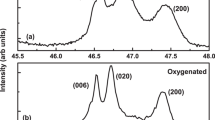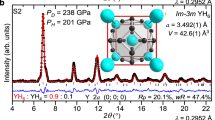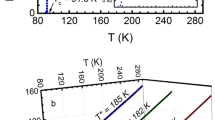Abstract
Just after Wu et al.1 reported superconductivity above 90 K in barium, yttrium and copper ternary oxides, the formula (YBa2Cu3O7−x) and the structural arrangement (oxygen-deficient tripled-perovskite-type structure) of the superconducting phase was proposed by different groups. As theoretical proposals depend crucially on the details of the atomic arrangement reducing the dimensionality of the system, a number of structural determinations were carried out by X-ray, neutron and electron diffraction. Although these studies established the structure of the metal framework (the ordering of Ba and Y in the sequence Y–Ba–Ba being responsible for tripling the crystallographic c axis), discrepancies persist regarding the position of the oxygen vacancies. X-ray experiments on single crystals2–3 have reported that the oxygen vacancies are distributed in an ordered way in the plane containing Y atoms (z = 1/2) and statistically in the plane at z = 0. High-resolution neutron-powder diffraction4,5 showed, on the other hand, a reduction in the structure dimensionality. The oxygen vacancies in the plane at z = 0 are ordered along the a-axis, so that one-dimensional chains of square-coordinated copper ions parallel to the b–c plane are formed. These results, confirmed by electron diffraction6, justify the reduction of crystal symmetry from tetragonal to orthorhombic observed in several studies. Structural differences between X-ray and neutron diffraction studies were attributed4 to the fact that single crystals used in X-ray measurements were probably highly twinned. But neutron experiments need large amounts of material, increasing the possibility of the samples being inhomogeneous. Here we report X-ray structure determination on a YBa2Cu3O7 single crystal showing a Tc above 90 K. The results, in agreement with neutron-powder diffraction, confirm the complete ordering of the oxygen vacancies leading to the one-dimensional chains.
This is a preview of subscription content, access via your institution
Access options
Subscribe to this journal
Receive 51 print issues and online access
$199.00 per year
only $3.90 per issue
Buy this article
- Purchase on Springer Link
- Instant access to full article PDF
Prices may be subject to local taxes which are calculated during checkout
Similar content being viewed by others
Author information
Authors and Affiliations
Rights and permissions
About this article
Cite this article
Calestani, G., Rizzoli, C. Crystal structure of the YBa2Cu3O7 superconductor by single-crystal X-ray diffraction. Nature 328, 606–607 (1987). https://doi.org/10.1038/328606a0
Received:
Accepted:
Issue Date:
DOI: https://doi.org/10.1038/328606a0
This article is cited by
-
Paramagnons and high-temperature superconductivity in a model family of cuprates
Nature Communications (2022)
-
Structural, electronic, and thermoelectric properties of La2CuBiS5
Science China Materials (2017)
-
Optically enhanced coherent transport in YBa2Cu3O6.5 by ultrafast redistribution of interlayer coupling
Nature Materials (2014)
-
Investigation of the relationship betweenT c and the Coulomb interaction of copper cations from the neighboring CuO2 layers
Journal of Structural Chemistry (1999)
-
In-air preparation of optimally doped YBCO
Il Nuovo Cimento D (1997)
Comments
By submitting a comment you agree to abide by our Terms and Community Guidelines. If you find something abusive or that does not comply with our terms or guidelines please flag it as inappropriate.



